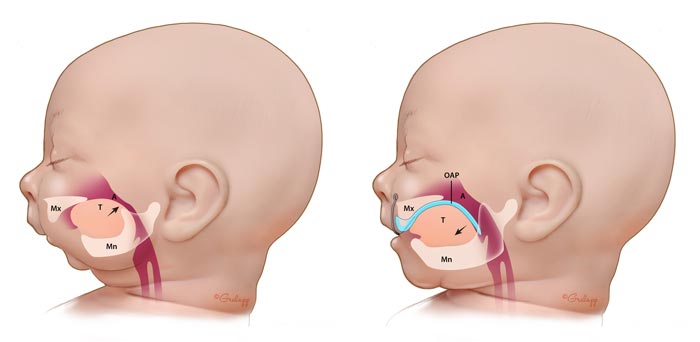The Stanford OAP is a nonsurgical, removable oral device, something like an orthodontic retainer. It is created by HyeRan Choo, DDS, DMD, MS’s OAP designing method using medical imaging, to customize it specifically for each baby. As soon as the Stanford OAP is placed in the baby’s mouth, it immediately opens up the airway. The OAP helps correct defects in the baby’s airway, jaw, and palate.
What Is Stanford OAP?
Every baby should be able to breathe and eat comfortably at all times. The Stanford Orthodontic Airway Plate (OAP) Treatment Program is an effective, noninvasive treatment for many babies born with breathing and feeding difficulties caused by abnormal tongue position, and for whom surgery such as tongue-lip adhesion, jaw distraction, or tracheostomy was once the only treatment option.
It takes only a couple of days for Dr. Choo to fashion the Stanford OAP. As soon as it is ready, Dr. Choo and an otolaryngologist fit the Stanford OAP inside the baby’s mouth under nasal endoscopy (a tiny camera entering through the nose and showing the inside of the throat) to confirm its optimal position enhancing breathing and swallowing.
 The narrow airway (A) in an infant, left, is enlarged with the Stanford OAP, right
The narrow airway (A) in an infant, left, is enlarged with the Stanford OAP, right
The treatment requires neither general anesthesia nor intubation. It typically takes a few days for a baby to get used to wearing the OAP. Pressure sores are common at the start of treatment; they resolve by themselves with minor adjustments. Once the baby is used to the OAP, oral feeding exercises are initiated to help the baby experience the pleasure of feeding by mouth with minimal stress. They learn how to pace themselves for comfortable suck-swallow-breathe on their own. Properly toned muscles of the face and neck through proper oral feeding exercises with the OAP-augmented oral structures are key to accelerated growth of the lower jaw and airway. Therefore, a robust and regimented OAP-enabled oral feeding exercise is an integral part of the Stanford OAP treatment protocol.
The OAP is removed from the baby’s mouth for cleaning just once a day. Otherwise, the baby wears it at all times until the end of treatment. Parents learn how to put the OAP in the baby’s mouth and take it out while the baby is still in the hospital. This may be daunting at first, but with a little practice, it is not difficult. It takes parents about a week to get good at handling the OAP.
The initial hospital stay with the Stanford OAP is approximately two weeks after the baby starts to wear the OAP. Total treatment duration varies from weeks to months, depending on the initial size of the lower jaw. The smaller the lower jaw is, the longer it takes to grow it naturally. Therefore, the Stanford OAP is periodically adjusted during outpatient visits, after the initial hospital stay. The total number of outpatient visits for the OAP adjustment varies from one to four times, with a four- to six-week interval on average. The purpose of these adjustments is to accelerate growth of the lower jaw and to accommodate the natural growth of the upper jaw of a growing baby. As the jaw grows, the airway naturally enlarges too, and the facial form moves into balance.
Babies graduate from the Stanford OAP treatment program when their tongue has learned healthy positioning inside the mouth and their lower jaw has grown to match the upper jaw gumline. By the time of graduation, most babies feed 100% by mouth.
Connect with us:
Download our App: